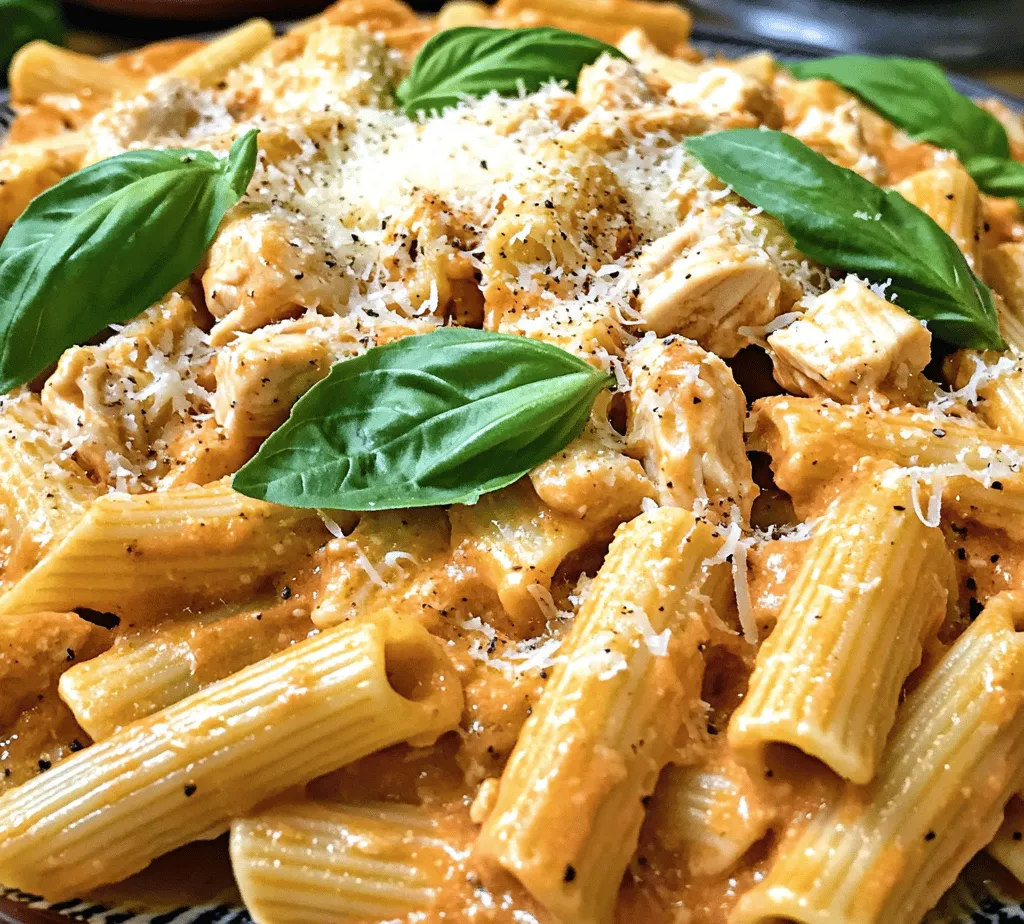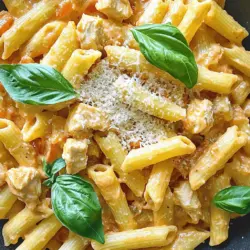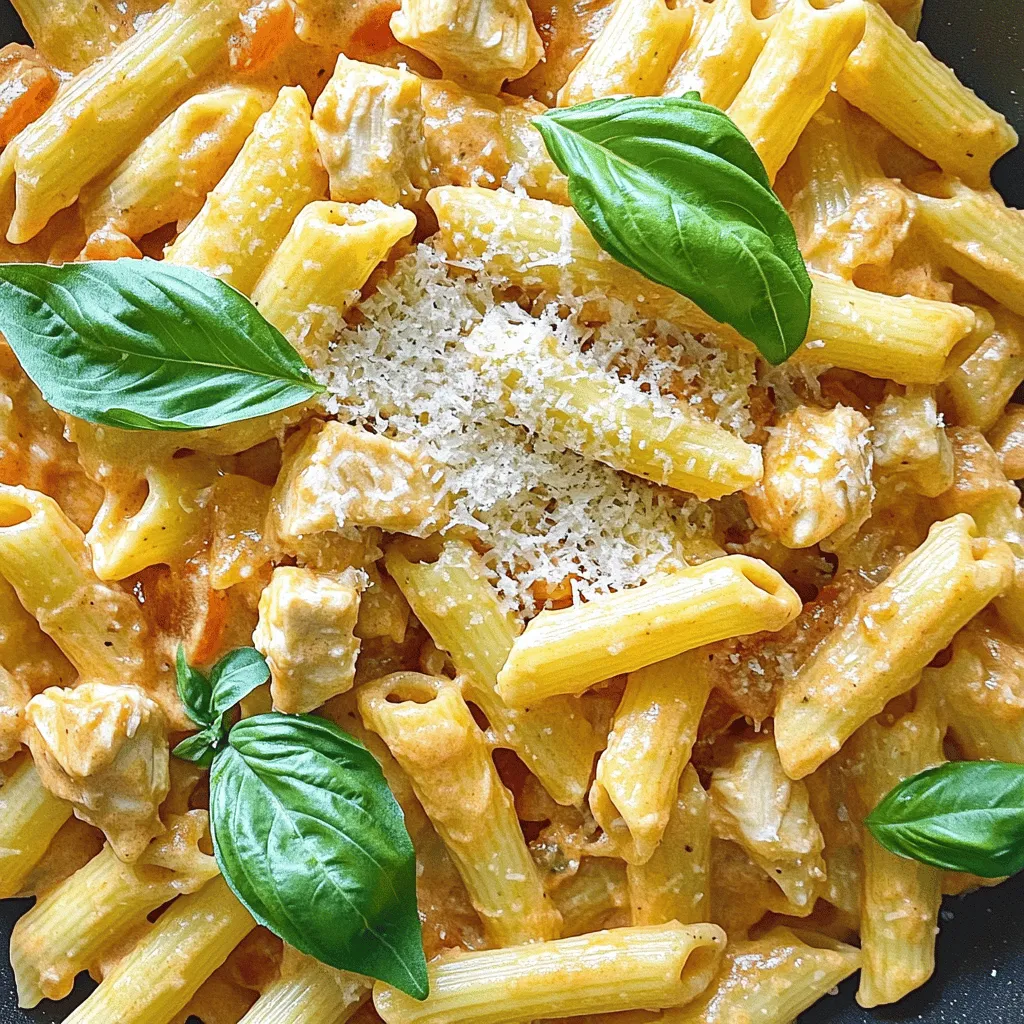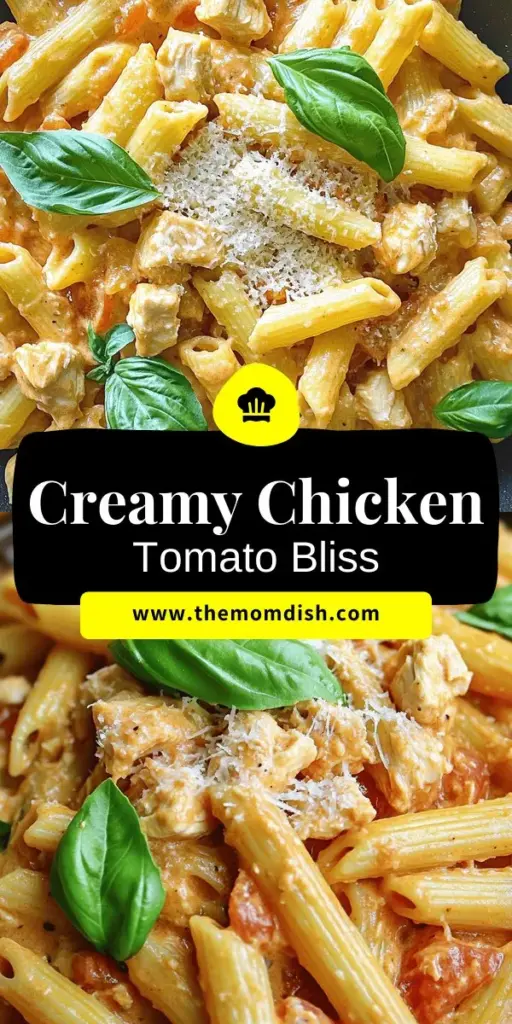Introduction
Creamy Chicken Tomato Pasta with Pesto is a dish that effortlessly combines rich, savory flavors with a refreshing twist. This delightful meal brings together tender chicken, al dente pasta, and a luscious sauce that elevates weeknight dinners and impresses guests alike. The creamy texture complements the tangy notes of crushed tomatoes while the basil pesto adds a fresh, herbaceous quality that ties all the elements together. Whether you’re cooking for a busy family or hosting a gathering, this recipe is sure to please palates of all ages.
What makes this dish so special is its versatility; it can be a quick weeknight dinner that comes together in under an hour or a sophisticated dish that shines at dinner parties. The blend of flavors and textures—from the juicy chicken to the velvety sauce—will leave you craving more. Let’s explore the ingredients that make this dish a standout, and prepare ourselves for a cooking adventure that will tantalize the taste buds.
Understanding the Ingredients
Creating a memorable Creamy Chicken Tomato Pasta with Pesto begins with understanding the key ingredients that contribute to its flavor profile. Each component plays a vital role, and selecting fresh, high-quality items can elevate your dish to new heights.
Chicken Breasts: Source of Protein
At the heart of this dish is the succulent chicken breast, which serves as a robust source of protein. When cooked properly, chicken breast becomes juicy and tender, providing a satisfying bite that complements the pasta. It’s important to choose boneless, skinless chicken breasts for ease of preparation and to ensure a consistent texture throughout the dish.
Penne Pasta: Ideal Shape for Holding Sauce
The choice of pasta can significantly impact the overall experience of the dish. For this recipe, penne pasta is the ideal choice due to its tubular shape and ridges, which help trap the creamy sauce and bits of chicken. This means that every bite is filled with flavor, making each mouthful satisfying and delicious. You can also experiment with other pasta shapes, but penne’s structure is particularly well-suited for this creamy concoction.
Crushed Tomatoes: Base of the Sauce Providing Acidity
Crushed tomatoes form the base of the sauce, contributing acidity and a vibrant color. They add depth and complexity to the dish, balancing the richness of the cream and the pesto. When selecting crushed tomatoes, look for high-quality varieties, preferably those canned at the peak of ripeness, to ensure a robust flavor that will shine through in your sauce.
Heavy Cream: Adds Creaminess and Richness
Heavy cream is what transforms this dish into a decadent experience. It adds a luxurious creaminess that envelops the pasta and chicken, creating a rich sauce that clings beautifully to each bite. While you can substitute with lighter creams or even plant-based alternatives, heavy cream offers the richest flavor and texture that this recipe calls for.
Basil Pesto: Enhances Flavor with Fresh Herbs
Basil pesto is a game-changer in this dish. It infuses a burst of fresh herb flavor that brightens the sauce and adds an aromatic quality that is simply irresistible. You can either make your own pesto using fresh basil, pine nuts, garlic, olive oil, and Parmesan cheese, or purchase a high-quality store-bought version. Either way, the pesto is essential for achieving that signature flavor that defines this pasta dish.
Importance of Using Fresh Ingredients for Maximum Taste
One of the keys to a successful Creamy Chicken Tomato Pasta with Pesto is the use of fresh ingredients. Fresh vegetables, herbs, and quality proteins not only enhance the flavor but also contribute to a more vibrant and appealing dish. When possible, opt for local produce and high-quality meats to experience the best flavors. Fresh ingredients can elevate an ordinary meal into an extraordinary culinary experience.
Preparation Steps
Now that we’ve covered the importance of each ingredient, let’s dive into the preparation steps that will lead us to a delicious plate of Creamy Chicken Tomato Pasta with Pesto.
Cooking the Pasta: Importance of Salt in Boiling Water
Start by bringing a large pot of salted water to a rolling boil. The salt is crucial as it not only flavors the pasta but also helps to enhance the overall taste of the dish. Once the water is boiling, add in the penne pasta. Cook according to package instructions until al dente, usually about 10-12 minutes. Remember to stir occasionally to prevent the pasta from sticking together.
Once cooked, reserve a cup of pasta water for later use and drain the rest. Do not rinse the pasta, as you want to retain the starch that will help the sauce adhere better.
Cooking the Chicken: Techniques for Achieving Golden Brown Color
While the pasta is cooking, it’s time to prepare the chicken. Begin by slicing the chicken breasts into bite-sized pieces. This ensures they cook evenly and absorb the flavors of the sauce. Season the chicken generously with salt and pepper for added flavor.
In a large skillet over medium-high heat, heat a tablespoon of olive oil until shimmering. Add the chicken pieces in a single layer, ensuring not to overcrowd the pan. This is key to achieving that golden-brown crust that adds both flavor and texture. Cook for about 5-7 minutes, turning occasionally, until the chicken is cooked through and has a beautiful golden color. Remove the chicken from the skillet and set it aside.
Sautéing Aromatics: How Onions and Garlic Elevate the Dish
In the same skillet, add another tablespoon of olive oil if necessary. Once the oil is hot, add finely chopped onions and sauté for about 3-4 minutes until they become translucent and fragrant. Next, add minced garlic and cook for an additional 30 seconds, being careful not to let it burn. The combination of sautéed onions and garlic adds a wonderful depth of flavor to the sauce, creating a fragrant base that will elevate the entire dish.
Visual Cues to Look for During Each Cooking Stage
As you progress through the cooking process, keep an eye on visual cues to gauge doneness. The pasta should be tender yet firm to the bite, the chicken should be golden brown and cooked through, and the onions should be soft and translucent. These cues ensure that each component is cooked to perfection, leading to a harmonious blend of flavors in the final dish.
By following these initial steps, you’ll set a solid foundation for your Creamy Chicken Tomato Pasta with Pesto, ensuring that each ingredient shines through in the final presentation. In the next section, we will delve into how to create the perfect sauce to complete this delectable meal, blending all these elements into a cohesive dish that is sure to impress.

Breaking Down the Sauce Creation Process
Creating the perfect sauce for your creamy chicken tomato pasta starts with mastering the fundamentals. The sauce is the heart of this dish, and understanding how to build it will elevate your culinary skills. Begin by heating a splash of olive oil in a large saucepan over medium heat. Once the oil is hot, add minced garlic and diced onions, sautéing them until they become translucent. This step is crucial as it creates a fragrant base that will deepen the flavor profile of your sauce.
Next, add the crushed tomatoes to the pan. This is where the magic begins. Simmering crushed tomatoes allows the natural flavors to meld together, resulting in a rich and flavorful sauce. It’s essential to let the tomatoes cook for about 10-15 minutes, stirring occasionally. This simmering time helps to concentrate the flavors, and the tomatoes will reduce slightly, thickening the sauce.
As the tomatoes simmer, you can start balancing the flavors. Pour in the heavy cream and stir gently to combine. The cream not only adds richness but also mellows the acidity of the tomatoes. Finally, incorporate the pesto. Pesto brings in a fresh, herby flavor that complements the tomatoes and cream perfectly, creating a well-rounded sauce that coats the pasta beautifully.
Tips on Achieving the Right Consistency for the Sauce
Achieving the right sauce consistency is crucial for a perfect creamy chicken tomato pasta. If your sauce is too thick, you can thin it out by adding a splash of chicken broth or pasta water. Conversely, if the sauce is too runny, continue simmering it until it thickens to your liking. Keep in mind that it will also thicken slightly as it cools, so it’s better to err on the side of a slightly thinner sauce.
Discussing Potential Variations and Substitutions for Sauce Ingredients
This creamy chicken tomato pasta sauce is versatile, allowing for various substitutions based on dietary preferences or ingredient availability. For instance, if you’re looking to make the dish lighter, consider using half-and-half or a plant-based cream alternative. You can also swap out the pesto with sun-dried tomato paste for a different flavor profile.
If you prefer a dairy-free dish, you can use coconut milk instead of heavy cream and nutritional yeast instead of cheese. For an added kick, incorporate crushed red pepper flakes or diced bell peppers into the sauce for a spicy twist.
Combining Ingredients for a Harmonious Flavor
Once your sauce is ready, it’s time to combine all the elements for a truly harmonious flavor. Start by cooking your pasta according to the package instructions until al dente. Reserve a cup of pasta water before draining, as it can be used to adjust the sauce’s consistency later on.
In a large mixing bowl, combine the cooked pasta with the sauce, ensuring every strand is coated. It’s important to use gentle folding techniques to maintain the integrity of the pasta. Stirring too vigorously can break the pasta and create a mushy texture. If the sauce feels too thick, gradually add some reserved pasta water to loosen it up.
Importance of Gentle Folding to Maintain Pasta Integrity
Gentle folding is a technique that can’t be emphasized enough. The goal is to create a seamless integration of pasta and sauce without compromising the pasta’s shape. Use a spatula or tongs to lift and turn the pasta, allowing the sauce to envelop it rather than mashing it together. This method preserves the al dente texture, ensuring that every bite is a delightful combination of creamy sauce, tender chicken, and perfectly cooked pasta.
Adjusting Seasoning to Taste: How to Enhance Flavors Effectively
Once the pasta and sauce are combined, the final touch involves adjusting the seasoning. Taste the dish and add salt, pepper, or additional pesto as needed. A sprinkle of freshly ground black pepper or a few pinches of salt can elevate the flavors significantly. Remember, seasoning is essential, and the right balance will bring your creamy chicken tomato pasta to life.
Serving Suggestions
Presentation is key in turning a simple meal into an impressive dish. For a beautiful presentation, serve your creamy chicken tomato pasta in shallow bowls. Garnish with freshly chopped basil, which adds a pop of color and a burst of freshness. A generous sprinkle of grated Parmesan cheese on top not only enhances the flavor but also adds a touch of elegance to the dish.
When it comes to pairing options, a crisp green salad with a light vinaigrette complements the richness of the pasta beautifully. A side of garlic bread or a baguette is also a great option for those who want to soak up the delicious sauce.
For larger gatherings, this recipe can easily be doubled or tripled. Simply scale the ingredients accordingly and prepare in larger pots. Make sure to adjust cooking times for the pasta and sauce to ensure everything is cooked evenly.
Nutritional Information
Understanding the nutritional content of your meals can help you make informed choices. In a standard serving of creamy chicken tomato pasta, you can expect approximately 600-700 calories, depending on the specific ingredients used. Here’s a general breakdown per serving:
– Calories: 650
– Protein: 30g (from chicken and cheese)
– Fats: 35g (from cream and olive oil)
– Carbohydrates: 70g (from pasta and tomatoes)
Each ingredient in this dish contributes nutritional benefits. Chicken provides lean protein essential for muscle health, while crushed tomatoes are rich in antioxidants and vitamins, particularly vitamin C. Pesto, made from fresh basil and nuts, adds healthy fats and nutrients.
If you’re looking to lighten the dish, consider using whole wheat pasta, which provides additional fiber and nutrients. You can also reduce the amount of cream or use a low-fat alternative to cut down on calories without sacrificing flavor.
Conclusion
In summary, creamy chicken tomato pasta is not only a delightful dish but also an easy one to prepare. Its appealing flavors and creamy texture make it a favorite among both adults and children. The sauce creation process, from simmering crushed tomatoes to balancing flavors with cream and pesto, ensures a rich and satisfying meal.
Encouraging you to try this recipe is easy—once you experience the blend of flavors and the simplicity of preparation, you’ll want to add it to your weeknight meal rotation. Whether you’re cooking for a family dinner or a cozy date night, this creamy chicken tomato pasta is sure to impress. So gather your ingredients, follow the steps, and enjoy a delightful dining experience that brings warmth and comfort to your table.



